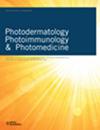Phototherapy in the artificial intelligence era.
IF 2.2
4区 医学
Q2 DERMATOLOGY
Photodermatology, photoimmunology & photomedicine
Pub Date : 2023-09-01
Epub Date: 2023-05-31
DOI:10.1111/phpp.12890
引用次数: 0
Abstract
Dear Editor, Artificial intelligence (AI) based on machine learning and convolutional neuron networks is rapidly becoming a realistic prospect in Dermatology.1,2 Due to the unique nature of Dermatology, AIaided dermatological diagnosis based on image recognition has become a current focus and future trend.3 In recent studies, AI algorithms have shown promising results for diagnosing nonmelanoma skin cancer and melanoma, with a diagnostic accuracy comparable with that of skin experts.1– 3 The use of 3D imaging systems allows clinicians to screen and label skinpigmented lesions and distributed disorders, which can provide an objective assessment and image documentation of lesion sites.3 Dermatoscopes combined with intelligent software help the dermatologist to easily correlate each closeup image with the corresponding marked lesions in the 3D body map.3 AI's emerging applications in Dermatology include diagnosing, managing, and monitoring other skin diseases, including inflammatory and autoimmune diseases.4,5 Phototherapy consists of the therapeutic use of ultraviolet radiation (UV). It can be performed with ultraviolet A (UVA) or ultraviolet B (UVB) radiation.6 The wavelengths administered and the UV radiation doses vary according to the proposed indication.7 Although psoriasis is the most frequent indication, it is used for atopic dermatitis, vitiligo, prurigo nodularis, cutaneous Tcell lymphoma, and cutaneous sclerosis.6,7 AI can revolutionize phototherapy in several ways. For example, AI algorithms could be developed to analyze patient data and provide an individualized phototherapy treatment by calculating the Minimum Erythematous Dose (MED) or according to the patient's phototype. It would therefore be of great help to use AI algorithms to provide personalized phototherapy protocols with optimal UV doses and exposure duration. Additionally, AI algorithms could be programmed to analyze the patient's skin response and adapt treatment. AI could monitor the patient's response to phototherapy in realtime by assessing disease severity scores8,9 (e.g., Psoriasis Area Severity Index, SCORing Atopic Dermatitis, Eczema Area and Severity Index, Prurigo Activity and Severity Score), calculating affected body surface8,9 area and detecting skin cancers.3 This could help to optimize the treatment and ensure better results. Additionally, AI could suggest alternative therapeutic strategies or combined topical and systemic therapies in case of phototherapy failure and acute phototoxic adverse effects. Emma et al.,10 used machine learning to determine which psoriasis patient characteristics are associated with longterm responses to biologics. From the same perspective, AI can be used to analyze large datasets of patient information and identify patterns that can help predict phototherapy's effectiveness for specific conditions. In the near future, AI can help clinicians make better treatment decisions and improve patient outcomes. Artificial Intelligence in Health and Care Award supports AI solutions across the development pathway, from initial feasibility to clinical implementation, and includes one interesting project in this area.11 The PREVAIL (PhototheRapy Enhanced Via Artificially Intelligent Lasers) project is currently developing automated techniques for treating psoriasis through the targeted delivery of laser light.12 This could reduce the risk of skin cancer in adjacent skin caused by current treatments with UVB, where the unaffected and affected skin has often been exposed to UVB rays.12 The AIMATS (Artificial IntelligenceMediated Assessment and Treatment of Skin disease) Vitiligo is developing a way to train a computer to recognize vitiligo from photographs of these patients.13 This approach could help clinicians assess the severity of vitiligo more accurately, including during treatment.14 Additionally, using AI may allow ultraviolet light treatment to be pointed only to the vitiligo (avoiding the sideeffect of regular skin tanning) during ultraviolet light treatment, leading to better cosmetic results.13 AI plays a tremendous role in dermatology. However, applying AI algorithms in clinical practice needs to be revised.1,2,4,5 Limitations concerning the lack of generalizability and standardization must continue to be addressed.1,2,5 Finally, the clinician's role remains vital, as no machine can replace a humantohuman relationship.1 Still, we have a tool that can enhance medical care if we use it rationally under the correct guidance and supervision. Integrating AI into phototherapy can improve treatment outcomes and make phototherapy more personalized and effective for each patient. AI's applications could potentially prove beneficial to the entire field of dermatology. However, reallife clinical trials using AI algorithms are needed to amplify their potential use in everyday practice.3 Whether we embrace it or not, a new era is spreading ahead.人工智能时代的光疗。
本文章由计算机程序翻译,如有差异,请以英文原文为准。
求助全文
约1分钟内获得全文
求助全文
来源期刊
CiteScore
4.40
自引率
7.70%
发文量
85
审稿时长
6-12 weeks
期刊介绍:
The journal is a forum for new information about the direct and distant effects of electromagnetic radiation (ultraviolet, visible and infrared) mediated through skin. The divisions of the editorial board reflect areas of specific interest: aging, carcinogenesis, immunology, instrumentation and optics, lasers, photodynamic therapy, photosensitivity, pigmentation and therapy. Photodermatology, Photoimmunology & Photomedicine includes original articles, reviews, communications and editorials.
Original articles may include the investigation of experimental or pathological processes in humans or animals in vivo or the investigation of radiation effects in cells or tissues in vitro. Methodology need have no limitation; rather, it should be appropriate to the question addressed.

 求助内容:
求助内容: 应助结果提醒方式:
应助结果提醒方式:


